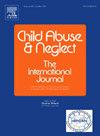与其他神经成像方式相比,眼科超声检查可以更快、更准确地识别与虐待性头部创伤相关的视网膜损伤
IF 3.4
2区 心理学
Q1 FAMILY STUDIES
引用次数: 0
摘要
背景与目的我们认为,与眼底扩张检查相比,眼超声检查(us)比头部计算机断层扫描(CT)或脑磁共振成像(MRI)能更快、更准确地识别视网膜病变。方法采用多机构前瞻性观察队列研究方法,选取经神经影像学证实的4岁儿童重症监护病房疑似创伤性脑损伤患者。所有患者都进行了床边检查和眼底扩张检查、尸检或两者兼而有之。根据机构TBI方案获得头部CT和脑MRI图像。结果入选50例患者,男37例,女13例,平均年龄4个月,智商2 ~ 14岁。颅脑ct 38张,mri 39张。在扩张型眼底镜检查中,24名受试者有双侧视网膜出血,2名有单侧视网膜出血,24名无视网膜病变。在到达医院后3小时内(SD±2)获得了OUSs,在3.2(±4.2)小时内获得了头部ct,在56(±75)小时内获得了脑部mri,在65(±56)小时内获得了眼底检查。与眼底检查相比,头部CT诊断视网膜病变的敏感性为35% (CI: 15-61),特异性为100% (CI: 81-100)。T2加权MRI的敏感性为44% (CI: 22-69),特异性为100% (CI: 37-77)。MRI敏感性加权成像敏感度为62% (CI: 36-84),特异性为85% (CI: 61-96)。OUS的敏感性为96% (CI: 80-99.8),特异性为100% (CI: 84-100)。结论超声对视网膜病变的诊断比其他神经影像学检查更准确,比眼底扩张检查更快。本文章由计算机程序翻译,如有差异,请以英文原文为准。
Ophthalmic ultrasonography can identify retinal injury associated with abusive head trauma more quickly and accurately than other neuroimaging modalities
Background and objectives
We propose that ophthalmic ultrasonography (OUS) can identify retinal pathology faster and more accurately than head computed tomography (CT) or brain magnetic resonance imaging (MRI) when compared with dilated fundus exam.
Methods
Children <4 years old admitted to the pediatric intensive care unit with suspected traumatic brain injury (TBI) confirmed by neuroimaging were enrolled in this multi-institution prospective observational cohort. All patients underwent bedside OUS exams and either a dilated fundus exam, an autopsy, or both. Head CT and brain MRI images were obtained per institutional TBI protocols.
Results
Fifty patients, 37 males and 13 females, with an average age of 4 months (IQ: 2–14) were enrolled. Thirty-eight head CTs and 39 brain MRIs were obtained. On dilated fundoscopy 24 enrollees had bilateral retinal hemorrhages, 2 had unilateral retinal hemorrhages, and 24 had no retinal pathology. OUSs were obtained within 3 h of hospital arrival (SD ± 2), head CTs within 3.2 (±4.2) hours, brain MRIs within 56 (±75) hours, and fundus exams within 65 (±56) hours. Compared to fundus exam, head CT had a sensitivity of 35 % (CI: 15–61) and specificity of 100 % (CI: 81–100) for identifying retinal pathology. T2 weighted MRI had a sensitivity of 44 % (CI: 22–69) and a specificity of 100 % (CI: 37–77). MRI susceptibility weighted imaging had a sensitivity of 62 % (CI: 36–84) and specificity of 85 %(CI: 61–96). OUS had a sensitivity of 96 % (CI: 80–99.8) and a specificity of 100 % (CI: 84–100).
Conclusions
OUS was more accurate than other neuroimaging modalities at detecting retinal pathology and can be obtained faster than dilated fundus exams.
求助全文
通过发布文献求助,成功后即可免费获取论文全文。
去求助
来源期刊

Child Abuse & Neglect
Multiple-
CiteScore
7.40
自引率
10.40%
发文量
397
期刊介绍:
Official Publication of the International Society for Prevention of Child Abuse and Neglect. Child Abuse & Neglect The International Journal, provides an international, multidisciplinary forum on all aspects of child abuse and neglect, with special emphasis on prevention and treatment; the scope extends further to all those aspects of life which either favor or hinder child development. While contributions will primarily be from the fields of psychology, psychiatry, social work, medicine, nursing, law enforcement, legislature, education, and anthropology, the Journal encourages the concerned lay individual and child-oriented advocate organizations to contribute.
 求助内容:
求助内容: 应助结果提醒方式:
应助结果提醒方式:


